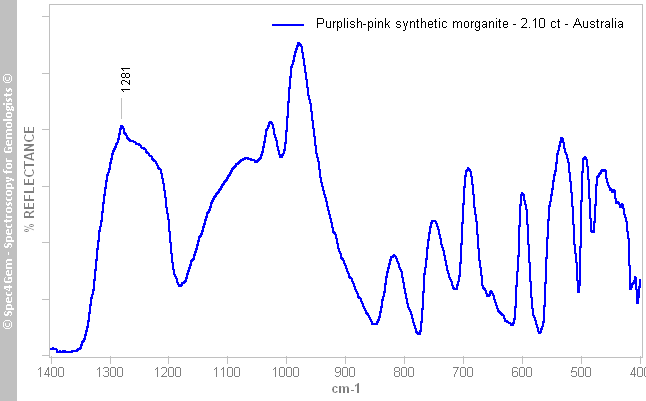Purplish-pink synthetic morganite
- Details
- Created: Tuesday, 12 December 2017 22:44
During 2017 fall, few stones were facetted from rough of synthetic morganite reportedly originating from Australia. I have not seen the rough in person.
The color of the stone is quite saturated and is almost purplish-pink (strong pink), see figure 1.
Literature about synthetic morganite is scarce and in general it deals with purple to red beryl. Few manufacturer are known to produce or to have produced in the past such material (Tairus, Biron in the 90's). A publication about Tairus material is available from geminterest website[2].
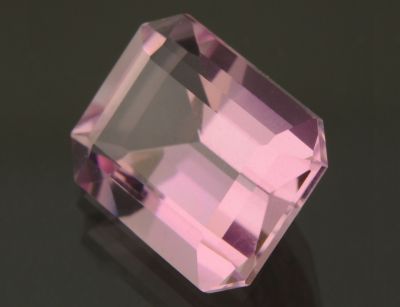 Figure 1. 2.10 ct purplish-pink synthetic morganite (pink beryl variety).
Figure 1. 2.10 ct purplish-pink synthetic morganite (pink beryl variety).| Shape | rectangular step cut (emerald cut) |
| Size | 9.0 x 7.1 x 5.0 mm |
| Color | purplish-pink |
| Lustre | vitreous |
| Weight | 2.10 ct |
| SG | 2.66 [Natural morganite: 2.80 [1], Synthetic morganite (Biron): 2.68-2.69 [1]] |
| RI | 1.570 - 1.577 [Natural morganite: 1.586 - 1.594 [1], Synthetic morganite (Biron): 1.571 - 1.578 [1]] |
| DR | 0.007 - U- [Natural morganite: 0.008 - 0.014 [1]] |
| Pleochroism | strongly purplish-pink /almost colorless |
| Polariscope / Conoscope | uniaxial figure observed down to the C-axis parallel to the length of the stone |
| SWUV | inert |
| LWUV | inert |
| Magnetic susceptibility N52 | diamagnetic |
| Chelsea filter | pink |
Table 1. Observational and measured properties
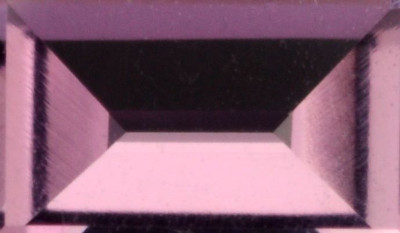 Figure 2. Striations observed on pavilion facets intersecting the C-axis.
Figure 2. Striations observed on pavilion facets intersecting the C-axis.They may be growing striations and for sure they are not cutting /
polishing marks. A striation of a facet defines a plane with its
counterpart on the opposite facet.
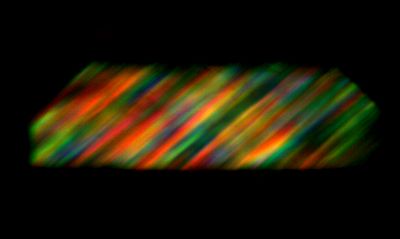 Figure 3. Interference colors observed from the pavilion down to
Figure 3. Interference colors observed from the pavilion down toC-Axis. The facet corresponds to the facet showing striations in figure 2.
Microscope observation does not reveal any particular inclusion, the stone is clean. It is however possible to observe particular interference colors down to the C-axis shown in figure 2, possibly related to growth structure or to the seed used in the possible hydrothermal process.
Infrared reflectance spectroscopy:
The IR reflectance spectrum (figure 4) was acquired from the stone's table and it shows the table plane is almost parallel to the C-axis since the spectrum is characteristic of the beryl while acquired from a hexagonal prism face (1010). The lasts reflectance bands are at rather high wavenumbers (1281 cm-1). The bands' group between 900 and 1150 cm-1 shows merged bands even if they are all still separable, especially for the last ones around 1060 and 1120 and cm-1 that look like a large hump.
UV-VIS-NIR spectroscopy:
The polarized UV-Vis spectra of this 2.10 ct morganite are shown in figure 5, E||C in purple and E_|_C in pink. E||C spectrum is slightly offset for better clarity. Both spectra show similar features except they are more prominent in the E||C polarization than in the E_|_C one.
The ultra-violet is absorbed up to 400 nm. Two main bands are present at 496 and 542 nm resulting in the observed color. Few weak features are observed at 645, 663 and 685 nm, attributed to Cr3+ as observed in other beryl, especially in Cr-bearing emeralds. Other weak features at 735, 835, 922, 980 and a stronger one at 957 nm are attributed to the water in the beryl structure.
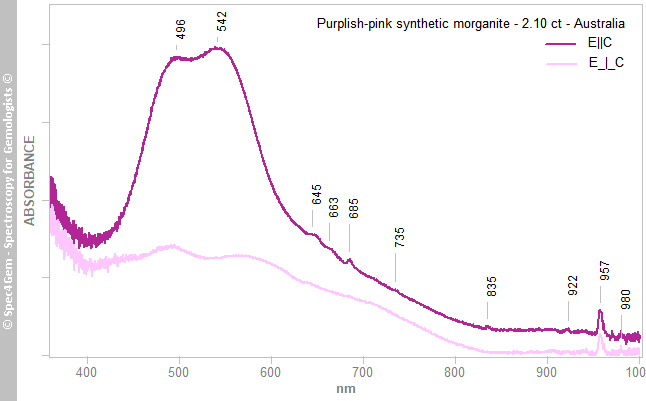 Figure 5. The polarized UV-Vis spectra (E||C in purple, E_|_C in pink) of this 2.10 ct morganite show 3 groups of features. The main group with two bands at 496 and 542 nm, a second group with Cr3+ features at 645, 663, and 685 nm, and a third one with water features at (735, 835, 922, 957 and 980).
Figure 5. The polarized UV-Vis spectra (E||C in purple, E_|_C in pink) of this 2.10 ct morganite show 3 groups of features. The main group with two bands at 496 and 542 nm, a second group with Cr3+ features at 645, 663, and 685 nm, and a third one with water features at (735, 835, 922, 957 and 980). Natural morganite is colored by manganese more likely by Mn2+ than by Mn3+, the color shifts from light-pink to red while Mn3+ amount increases (bixbite, red beryl). A peak fitting process of the main bands leads to the following results: 486 and 547 nm for E||C and 482 and 559 nm for E_|_C. These results are consistent with those of a morganite from USA showing bands at 480 and 555 nm as well as those of the red bixbite at 487 and 556 nm.
Morganite and bixbite show two secondary features at about 380 and 430 nm, that was initially attributed to Fe3+ but that now may be attributed to Mn3+. In this 2.10 ct morganite, these features are definitely missing.
Synthetic morganite produced by Biron in the 90's was doped with Ti3+ and the corresponding spectrum shows two bands at 495 and 550 nm. According to the bands position, there is no difference with these observed for Mn, except if observed with an handheld spectroscope, the natural morganite spectrum is almost unobservable while the synthetic one is easily observable.
Mn2+ with a 3d5 electronic structure often shows its two lowest energy transitions (ν1, ν2) in the visible region as two weak and broad bands.
Mn3+ with a 3d4 electronic structure has only one spin-allowed single band in the green region, the two bands appearance is the result of the Jahn-Teller splitting effect which usually produces asymmetric broad band. Such band can be deconvoluted to two bands.
Unlike Mn3+, Ti3+ has a 3d1 electronic structure and produces only one band in the visible region. Because of the Jahn-Teller splitting effect, it is an asymmetric broad band too.
Continuing with crystal field theory to try to determine the ions causing the color of this stone could be interesting but it is likely out of scope of such report.
Let's forget the exact bands' position and consider the spectra shapes, see figure 6, absorbance scale had been adjusted for each spectrum unless the morganite spectra would have been almost flat compared to others.
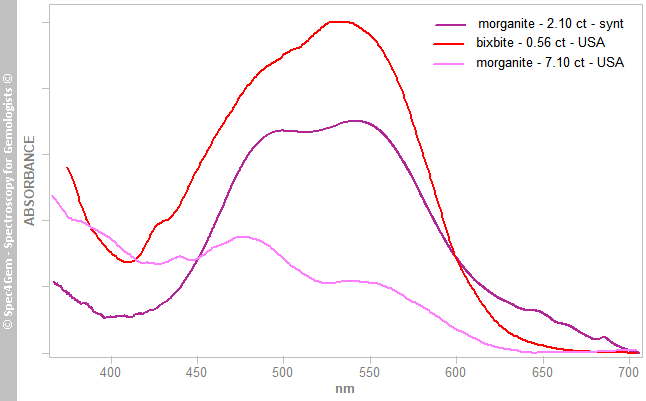 Figure 6. UV-Vis spectra comparison between this synthetic 2.10 ct morganite (purple) and a natural light-pink morganite from USA (pink) and a red bixbite from USA (red). Spectra are scaled to view the features of the light-pink morganite.
Figure 6. UV-Vis spectra comparison between this synthetic 2.10 ct morganite (purple) and a natural light-pink morganite from USA (pink) and a red bixbite from USA (red). Spectra are scaled to view the features of the light-pink morganite.The bixbite spectrum is not so different but its asymmetric broad band that looks like a dual band is usually rather strong. The spectrum pattern is quite constant in the samples of such material. Morganite spectrum is generally less prominent with very low absorption level giving thus the pink color. Its two main bands are rather distinct.
The present stone spectrum is closer to that of bixbite though it is quite different. The lack of the 380 and 430 nm weak features is not a determining factor but it makes sense to consider the stone is possibly colored by Ti3+. The other noticeable fact is the presence of Cr3+ that is consistent with the fact the Biron's morganites were hydrothermally manufactured of Cr-bearing beryl feeding materials.
Photoluminescence spectroscopy:
Photoluminescence was acquired with a 405 nm laser excitation but also with 442 and 532 nm lasers to excite the material where it has its main absorptions whatever it is Mn or Ti. The 405 nm excitation spectrum is given in figure 7, the 442 and 532 nm excitation spectra have been omitted since they are fully similar to the 405 nm excitation one except for a weak variation of the 687 nm peak position (442 nm excitation: 685 nm, 532 nm excitation: 686 nm and 405 nm excitation: 487 nm).
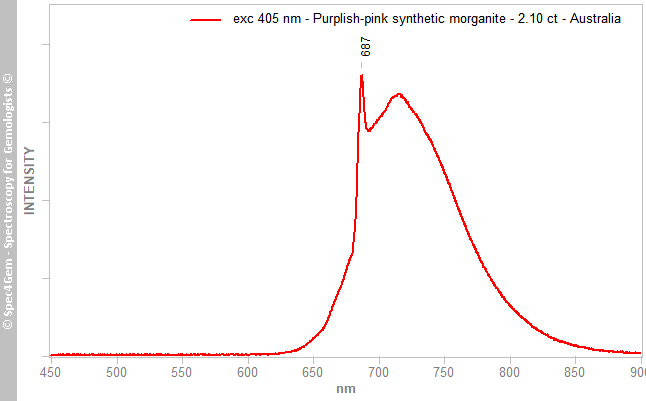 Figure 7. Photoluminescence spectrum with a 405 nm excitation producing a red emission ascribed to Cr3+. Mn luminescence is not observed.
Figure 7. Photoluminescence spectrum with a 405 nm excitation producing a red emission ascribed to Cr3+. Mn luminescence is not observed.The spectrum shows Cr3+ emissions with the 687 nm peak and the larger peak at 715 nm. The later emission peak could be ascribed to Mn4+ and V2+ if the stone contained Mn and/or V. The Mn2+/3+ emissions are not observed in the 550-650 nm range of this spectrum. The spectrum is similar to that of the Cr3+-bearing beryl (emerald).
Conclusion:
With its low range of physical properties (SG, RI), the lack of some features (Fe/Mn at 380 et 430 nm) usually present in morganite and bixbite spectra (UV-Vis spectroscopy), the presence of Cr3+ (UV-Vis and PL spectroscopies) and water as well as the lack of Mn (PL spectroscopy) lead to the following conclusion that this 2.10 ct purplish-pink synthetic morganite is very likely of Biron's manufacture, possibly from an old stock from the 90's. The Biron's historical material from the 90's has not flooded the market and the samples are rare, it is therefore complicated to get samples to make a comparative study.
[1] Gemmology, Peter G. Read, Elsevier editor, 2005, Third edition, ISBN: 0-7506-6449-5
[2] Les béryls synthétiques « Tairus » obtenus par dissolution hydrothermale - www.geminterest.com


